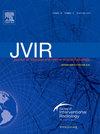Transhepatic Antegrade Gastric Variceal Sclerotherapy: Comparing Outcomes with and without Initial Efferent Vein Embolization
IF 2.6
3区 医学
Q2 PERIPHERAL VASCULAR DISEASE
Journal of Vascular and Interventional Radiology
Pub Date : 2025-01-01
DOI:10.1016/j.jvir.2024.09.026
引用次数: 0
Abstract
Purpose
To compare the effectiveness of percutaneous transhepatic obliteration (PTO) with initial afferent vein embolization (PTO-A) and with initial efferent vein embolization (PTO-E) for gastric varices (GVs).
Materials and Methods
Consecutive patients undergoing PTO-A or PTO-E for type 1 isolated GVs or type 2 gastroesophageal varices between June 2007 and February 2023 were included. PTO-A or PTO-E was indicated when balloon-occluded retrograde transvenous obliteration failed or there was no portosystemic shunt for the retrograde transvenous approach. PTO-A was performed for patients before March 2009 and for patients with multiple efferent channels from the GVs. PTO-E was attempted for patients after April 2009. Twenty-six patients were included, of whom 18 underwent PTO-A and 8 underwent PTO-E. In 12 patients, PTO-E was attempted without success, and they underwent PTO-A instead. The primary outcome was successful complete eradication of GVs within 1 week after the procedure. The secondary outcomes were the GV recurrence-free period and overall survival after the procedure.
Results
Technical success was achieved in all 26 patients, with complete GV eradication rates of 33.3% in PTO-A and 100% in PTO-E, significantly higher in PTO-E (P = .002). The median recurrence-free periods were 8.7 months with PTO-A and 75.1 months with PTO-E; PTO-E had a significantly longer recurrence-free period (P = .042). The median overall survival durations were 37.2 months with PTO-A and 49.9 months with PTO-E, with no significant difference (P = .955).
Conclusions
PTO-E had a better complete eradication rate and longer recurrence-free period than PTO-A for GVs.

经肝前胃静脉曲张硬化疗法:有无初始回流静脉栓塞的疗效比较
目的:比较经皮经肝静脉阻塞术(PTO)与初始传入静脉栓塞术(PTO-A)和初始传出静脉栓塞术(PTO-E)治疗胃静脉曲张(GVs)的疗效:纳入2007年6月至2023年2月期间因1型孤立胃静脉曲张或2型胃食管静脉曲张接受PTO-A或PTO-E治疗的连续患者。PTO-A或PTO-E适用于球囊闭塞逆行经静脉阻塞失败或逆行经静脉途径没有门静脉分流的患者。PTO-A 适用于 2009 年 3 月之前的患者以及 GV 有多条传出通道的患者。2009 年 4 月之后的患者尝试了 PTO-E。共纳入 26 例患者,其中 18 例接受了 PTO-A,8 例接受了 PTO-E。有 12 名患者在尝试 PTO-E 后没有成功,转而接受了 PTO-A。主要结果是术后 1 周内成功完全根除 GV。次要结果是术后无 GV 复发期和总生存期:结果:所有26名患者均获得了技术成功,PTO-A和PTO-E的GV完全根除率分别为33.3%和100%,PTO-E显著更高(p = 0.002)。PTO-A 的中位无复发期为 8.7 个月,PTO-E 为 75.1 个月;PTO-E 的无复发期明显更长(p = 0.042)。PTO-A的中位总生存期为37.2个月,PTO-E为49.9个月,无明显差异(p = 0.955):结论:与 PTO-A 相比,PTO-E 对 GVs 的完全根除率更高,无复发期更长。
本文章由计算机程序翻译,如有差异,请以英文原文为准。
求助全文
约1分钟内获得全文
求助全文
来源期刊
CiteScore
4.30
自引率
10.30%
发文量
942
审稿时长
90 days
期刊介绍:
JVIR, published continuously since 1990, is an international, monthly peer-reviewed interventional radiology journal. As the official journal of the Society of Interventional Radiology, JVIR is the peer-reviewed journal of choice for interventional radiologists, radiologists, cardiologists, vascular surgeons, neurosurgeons, and other clinicians who seek current and reliable information on every aspect of vascular and interventional radiology. Each issue of JVIR covers critical and cutting-edge medical minimally invasive, clinical, basic research, radiological, pathological, and socioeconomic issues of importance to the field.

 求助内容:
求助内容: 应助结果提醒方式:
应助结果提醒方式:


